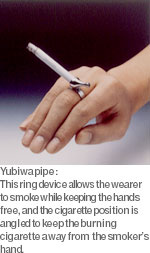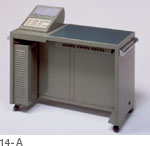December 1954: First prototype of all-electric compact calculator (relay model) completed
Kashio Seisakujo was a small subcontractor factory that made microscope parts and gears. Tadao had three younger brothers, Toshio, Kazuo, and Yukio. Toshio initially worked at the Tokyo office of the Ministry of Communications (now NTT) as a technician, building and equipping telegraph and telephone facilities. However, when Toshio saw how Tadao was toiling every day at his job, he began to wonder if he could come up with something to help his older brother with his career. As a child, the thoughtful Toshio had admired Edison, and told his family that he wanted to become an inventor when he grew up. With his extensive electrical knowledge, Toshio had already achieved results in system improvement at his workplace; however he decided to quit his job to go work at Kashio Seisakujo in order to really test his own abilities for innovation.

Utilizing his natural inventiveness, Toshio tried out several new ideas. One of these was “the yubiwa (finger ring) pipe.” At that time in postwar Japan, commodities were in short supply, and people smoked their cigarettes down to the very nub. For this reason, Toshio came up with a ring-mounted cigarette holder so that he could also smoke while doing his work. Tadao produced it on a lathe, and their father Shigeru went out to market it. Orders gradually began to pour in and the yubiwa pipe became a hit product soon after it was produced. The profits from this invention would later go towards the capital needed for development of a new kind of calculator.
Looking for a new product to follow the yubiwa pipe, the Kashio brothers laid eyes on foreign-made electric calculators at the first Business Show held in Ginza, Tokyo, in 1949. Most calculators at that time used mechanical gears, and there were none that employed electronic circuits like today’s devices. The main type of calculator used in Japan at that time was the hand-operated calculator, which employed gears and a hand crank. Although electric calculators using a small motor to turn the gears had already appeared overseas, they could not be manufactured in Japan, as a high level of technical expertise and special quality materials were needed in order to process the parts.
Although the electric calculator was faster than the hand-operated model, it was still much slower than calculators today, and since the gears turned at a high speed, it made a shrill noise. With his electrical knowledge, Toshio thought that he could resolve a lot of the problems by using all electrical circuits instead of mechanical parts, and decided to try to make his own calculator. Toshio used a type of electromagnet called a solenoid, and began development of an electric calculator without gears.
Tadao and Toshio soon found themselves working all day on subcontracting work to make a living, and then spending their evening hours absorbed in developing the calculator. They showed the prototype to people and then made improvements after getting feedback, and in this way worked out the various problems and bugs in the invention. After making ten or more prototypes, they completed Japan’s first electric calculator in 1954. The following year, the Kashio brothers proudly took their finished product to Bunshodo Corporation, the trading company handling office supplies, including calculators. Unfortunately, the Bunshodo representative told them that their calculator was out of date because it could not do continuing multiplication, wherein a multiplication product could be subsequently multiplied by another number.
Tadao and Toshio once again began spending their days working out the problems with the next prototypes. Around that time, both younger brothers, Kazuo and Yukio, also quit their jobs, and began working at Kashio Seisakujo. Toshio came up with the ideas, Yukio, who had taken mechanical engineering at university, drew the plans, and Tadao and Kazuo did the production. In 1956, six years after the start of development, they were close to completing a calculator with a continuing multiplication function, and all they had left to do was figure out how to mass-produce it. At this point, Toshio suddenly stated that he wanted to completely redesign the calculator. The solenoid design with its complicated mechanical structure meant potential difficulties for mass production. Toshio wanted to eliminate the solenoid design and use relays like those employed in the telephone exchange equipment of those days, in order to make a completely electric calculator.
Although computers using relays had already appeared by the late 1950s, they were so large that they required a whole room to themselves, complete with an air purification system. The disadvantage of relays was that they were easily affected by fine particles and dust. In order to solve this problem, special ingenuity was needed to bring electronic calculation to regular offices. First, the four Kashio brothers worked to reduce the number of relays from the several thousand (sometimes over ten thousand) used in the giant computers of the day to just 342, through improvements in the circuit design. They also developed an original new type of relay that was hardly affected by dust.

The greatest feature of the four brothers¡ new invention was the adoption of the ten-key format. The calculators at that time used what was called a “full keypad” with just the numerals 0 to 9 for all the digit places. This newly developed relay-type calculator used only 10 number keys, just like pocket calculators today.
A unique design was also adopted for the display. Calculators at that time had three display windows, and when calculating “100 + 200 = 300” the numerals “100,” “200,” and “300” were all displayed at the same time. However, with the relay calculator, the numbers disappeared after the next number was entered, and just the final answer appeared at the end. Today this seems like common sense, but at that time it was a revolutionary new idea, and it required a lot of hard work to get it accepted. With these innovations however, compact calculators were realized, and the office calculator was born.
Main functions
| Arithmetic functions: 14 digits
Fixed number memory: 3 groups of 5 digits |
|---|---|
Principal component
| Relays
|
Dimensions
| 1080mm wide, 780mm high, 445mm deep
|
Weight
| 140kg
|
Price
| ¥485,000
|